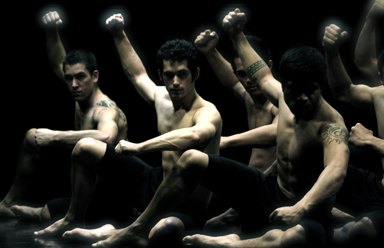Adventures in Dance Part II: Black Grace

My next night out took me to see New Zealand's powerhouse of a company, Black Grace. This show was a mixed repertoire show that included 7 fairly short pieces all created by the company’s Artistic Director, Neil leremia. The company of extraordinarily athletic dancers took to the stage, devouring the space with what felt like an explosive energy and a voracious appetite. What was immediately striking about these dancers is their exceptional level of commitment to every aspect of the dance: physical and spiritual and their extraordinary ability to coordinate speed and grace while maintaining a high standard of unison and technical excellence. The first piece, Fa’a Ulutao used five male dancers, and the combination of their radiant vitality and the nearly primordial sounding drum music drew me well into the dynamic and vigorous world of this company.
After the first piece, Ieremia came onto the stage to introduce his next piece, "Minoi". While at first I wondered if it was necessary for the Artistic Director to describe his work (shouldn't it speak for itself?), Ieremia was so affable and charming that I found myself liking all of his between-piece interjections.
Minoi also used all male dancers and contained a similar pace, athleticism and precision to the previous work. This piece was, as Ieremia explained, a variant of a traditional Samoan song – Ieremia’s Samoan background made its way into much of his work – and it included a great deal of clapping and slapping that elicited hoots and shouts from the audience, as encouraged by the lively dancers.
Later pieces included three female dancers, all of whom were equally as talented as the men, and as Ieremia noted, his male dancers were more attentive to their grooming for having had women recently join the company. While I’m sure this is a good thing, I occasionally felt that Ieremia’s one (minor) weakness was in using the strengths of these women. The style of their choreography was so similar to that of the men that I felt as though I didn’t get to see the women do what female dancers are usually best at. This is a company whose choreography seems to be heavy on athleticism, stamina, strength and powerful gestures, and the men excel at this. However, I felt that the women were being asked to dance as men in that none of the nuance that women’s bodies can bring to choreography was on display. It seemed as if they were treated as little men, required to keep up with the real men whose talents dominated the stage. It’s not that the women couldn’t keep up, as much as I didn’t feel that they got as much airtime as the men in terms of what they might excel at.
The final two pieces of the evening were both segments of a longer piece called Gathering Clouds which deals with the theme of immigrants leaving their homes behind for a new life, a new world. There were several gorgeous moments in these segments, pieces that contained a great deal of emotional depth and choreographic originality. One such moment had one of the male dancers climbing first onto the lap of one dancer, then onto another’s back and finally onto another’s shoulders, exhibiting a delicate grace and a powerful connection to each dancer he moved with. The last section of the evening was somewhat more traditionally “western” in its use of classical music, and in some way I found that this detracted from the vitality of the dancers, as if hushing them into a quieter existence than the previous, more raucous music had allowed. Still, the vibrancy of this company was present throughout, and I felt as though I could have watched them all night. With their original choreography, outstanding dancing and emotional presence, Black Grace is uplifting; the dancers, guided by Ieremia, could surely shatter their way through anyone’s emotional complacency and bring joy along with them.
Black Grace: gold medal.



